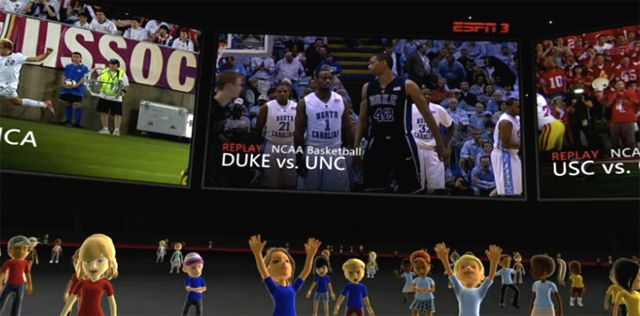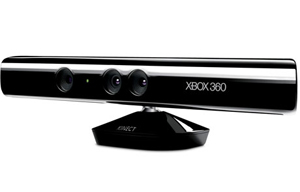
Each year, the Electronic Entertainment Expo (E3) showcases the games and technology that we will be playing over the foreseeable future. Often, that can mean products that are debuting in the Fall, or even those that are 1-2 years away from completion. These products guide the industry in design and technology for years, as consumers flock to those products that they find more enjoyable.
This year’s E3 continued that formula. The products that were on the show floor and behind closed doors displayed clear trends and direction for 2010 and onward as to what game designers and publishers are proposing to the gaming public. From technology, to visual design, to the cultural sphere around gaming, this year’s show was more subdued in blockbuster announcements, instead focusing on revision and evolution over revolution. Over the next few days we will discuss the leading trends that were apparent at the event. This is part 1 of 3.
Part 1: Technology
Trend: 3D Gaming
The major focus of Sony and Nintendo at the show was aimed towards 3-dimensional gaming. The technology has been hot and cold over the decades, found in film, books, and gaming. This time around, James Cameron’s film Avatar set the precedent for immersion with 3D visuals that were designed to place the viewer into the scene as opposed to having objects thrown out of it. It should be noted that 3D visuals are presumed to cause strain on eyes to some viewers.
Sony’s Playstation 3 console effort relies on special glasses and televisions, a technology that is in minimal adoption at the moment. Even with several impressive 3D titles set to arrive this year, such as Gran Turismo 5 and Killzone 3, the slow return of the economy has consumers hesitant to make large home purchases such as expensive new televisions with unproven technology.

Nintendo, on the other hand, is utilizing glasses-free technology that has been available on mobile devices for the past 2 years. Their 3DS portable allows for a narrow-angle glasses-free view of 3-dimensional visuals. “It really works,” was the common comment coming out of E3. Intent to purchase for the 3DS should be relatively high when it arrives, as consumers are ready to move on from the current DS and PSP generation.
There is an interesting phenomenon taking place with 3D. Most developers and publishers are currently exhibiting a “wait-and-see” attitude towards the technology in the living room, but are excited by the idea of a self-contained mobile 3D experience. The technology may be a nice-to-have for the PS3, but a driving force of sales for the 3DS.
Trend: Motion Control
Last year at E3, both Microsoft and Sony debuted their concepts for motion control, Natal (Kinect) and Move, respectively. This year, the updated technologies took center stage as the companies aimed to sell to distinctly different markets. Microsoft’s controller-less Kinect seemed focused on capturing the Wii’s casual crowd, while Sony showcased more core efforts such as FPS and racing games.
Both Microsoft and Sony are using motion control to extend the life of their respective consoles, with Microsoft also launching a a redesigned XBox 360 to coincide. Once again, Sony is adding support for the new tech to a large percentage of their future software, while Microsoft is leaning towards technology-specific games that cannot be played without the Kinect. Though the technologies are different, the software is still very similar, and we may not see “killer apps” until next year’s E3 show.
Trend: Cloud gaming

As ISP networks become more stable and quicker, Netflix-like streaming of video games is becoming a reality. Last year, OnLive debuted their service in early form, showcasing how games can be played without a console or disk and just a fast internet connection. Since then, the product has launched and companies like Gamestreamer and Gaikai have begun testing their own versions. Browser-based games have gone from fad to norm on desktops and laptops, as Facebook games like Farmville and Mafia Wars have consumed the time of millions of players.
OnLive has been the most publicized of the emerging group, with a technology that allows for playing of the newest games on even some considerably sub-par or older computers. With the popularity of Netflix streaming continuing to grow at an accelerated pace (appearing on all consoles and several mobile devices), the technology is just now becoming realized in the gaming world. Its advantages include near-perfect piracy control, play-anywhere (regardless of device), and accessibility; within a few minutes after signing up, anyone can play without purchasing any new hardware.
Expect the technology to continue to grow, especially once ISPs like Comcast and AT&T decide to partner with the service providers as early as next year.
Growing Trend: Augmented reality
Augmented reality became a buzz word in 2008 with the release of several novel apps for the iPhone 3G, and the 3GS in 2009. At this year’s show, augmented reality began to appear in the mobile platforms as well as on consoles. The technology brings realistic visuals or locations into the games that we play and meshes them with unique gameplay mechanics.
On the mobile front, Nintendo showcased a tech demo that wowed users. Using the 3DS and its exterior 3D cameras, the portable captured an image of a question block on a table. The image then transformed into a fully playable battle scene, showcased in the hand-held’s glasses-free 3D technology. Almost instantly showgoers began wondering what StarFox or Mario might look like in augmented reality.

Sony is utilizing the EyeToy in the EyePet software, due in 2010. The game uses live video of the users and overlays a 3D image of a creature that is played with, either hands-free or with the Move motion controls. The software can also interpret 2D images and sketches, allowing for even more interaction.
Though still fairly small, the use of augmented reality in gaming is being pushed more on portables than it is on consoles, thanks to location services and built-in motion sensors, but will remain a novelty experience for the foreseeable future.
Growing Trend: Everything to Everyone
When the PS3 launched on 2006, it prided itself on being the only console that gamers would need. Almost four years later, Sony has renewed its push with the “It Only Does Everything” campaign. Thanks to recent firmware updates the console can display Netflix and Hulu content, video editing, social network connectivity, and 3D gaming, along with the ever-expanding Home and Playstation Plus. Sony has capitalized on being first-to-market with recently new technology.

Microsoft is doing the same, albeit with more focus on networked tools such as Facebook, Twitter, and Netflix. Kinect is aimed at the casual audience, and ESPN and video conferencing is also coming this year.
These companies are hoping to expand the potential sales “bullet points” of their devices, as they work to capture the check list mentality of how consumers view value. Thanks to smart firmware updates, both Sony and Microsoft, along with Nintendo and its 3DS and Apple with its iOS devices, are able to continually expand the usability of their products. This is easily the “Most Functional Generation” of gaming products, to the point where gaming often takes a back seat to other applications. This will continue even more so with the growth of 3D and motion control.
Conclusion Part 1
This year marked the push for extending the life of the current console generation with new technology and a refocus on gaming audience. The key trends to consider going forward through 2010 and into 2011 are clearly based on the adoption of three key technologies: 3D, motion control, and cloud-hosted gaming. These trends are affecting both haptic interaction with and visual design of games and consoles.


1 Comment